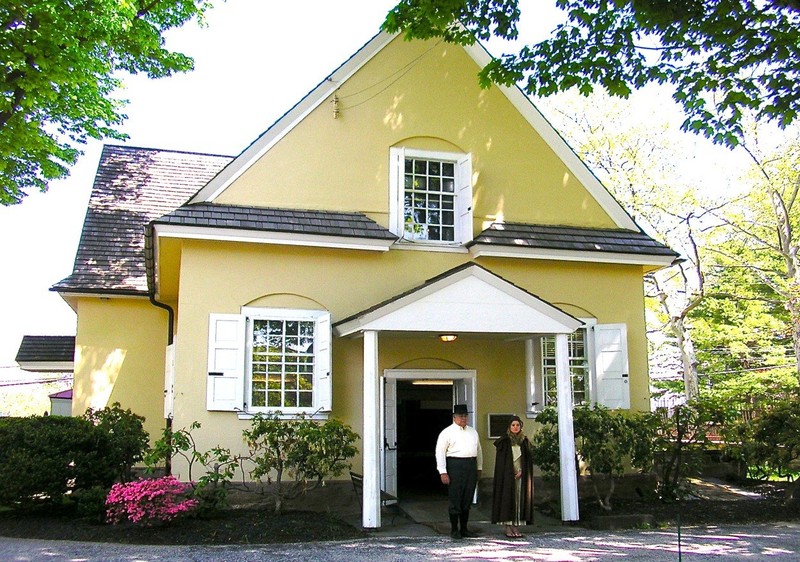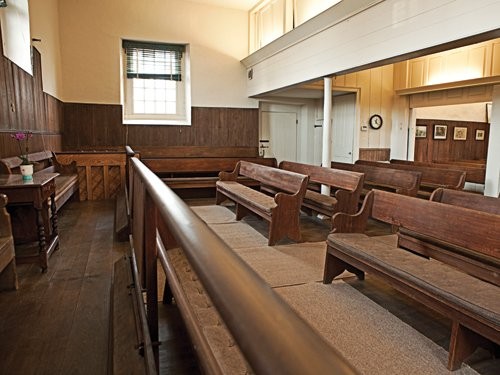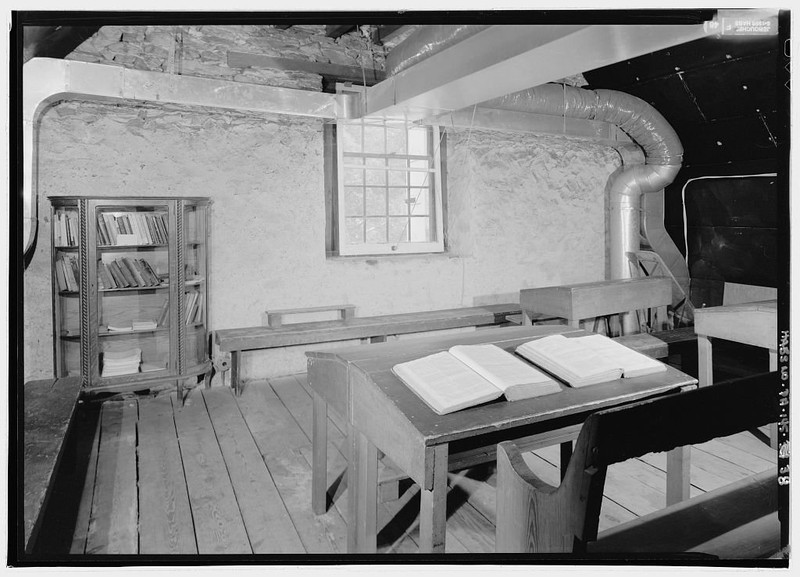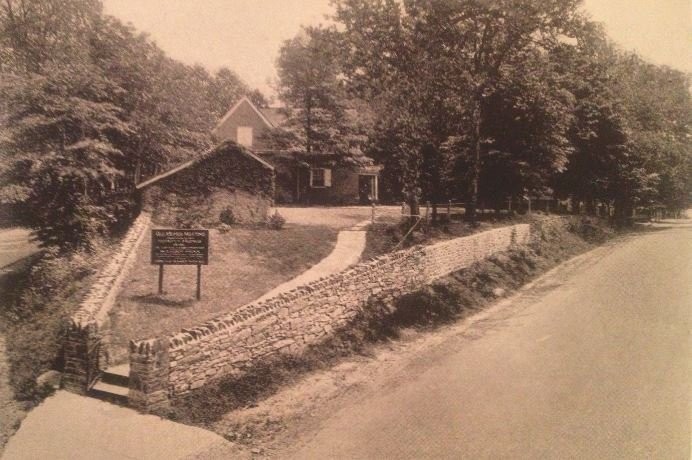Merion Friends Meeting House
Introduction
Text-to-speech Audio
Images
Period actors stand in front of the meeting house during its 2018 history festival.

The interior of the meeting house is simple and austere by design.

The second floor schoolroom.

The meeting house as it appeared in 1915.

A 1798 headstone within the Friend's burial ground located in the property.

Backstory and Context
Text-to-speech Audio
In 1682 members of the Society of Friends, or Quakers, arrived in Pennsylvania from Wales, becoming the first Celtic-speaking Welsh in the Western Hemisphere. Led by Edward Jones, they fled religious persecution in their homeland for the promise of religious freedom offered by William Penn. Quakers in the United Kingdom were considered traitors due to their refusal to swear oaths, especially oaths denouncing the Pope. They were also persecuted for their blasphemous religious practices, which included no sacred art or architecture and unprogrammed worship services with neither clergy, liturgy, nor sacraments. As a result, many were imprisoned, suffered corporal punishment and had their lands confiscated.
These self-named “Marioneth Adventurers” quickly established a monthly meeting just outside Philadelphia and began work on their meeting house in 1695. This first, or south, section was completed sometime around 1703 with the north section completed by 1714. Comprised of local Wissahickon schist, or stone, the Marion Meeting House was completed prior to the development of an American Quaker architectural template. It is thought this occurred because these Welsh Quakers arrived in America prior to the passage of the 1689 Act of Toleration back in England which allowed Quakers to practice freely and openly. Therefore, the Marion Meeting House is quite unique among American Quaker houses of worship.
Soon after, all meeting houses were designed and built in order to accommodate the practice of gender segregated business meetings, which caused divided structures with separate entrances. Marion Friends Meeting House looks more similar to a private residence than a house of worship. Its T-shaped, or tau design is also a unique feature as are its bent roof rafters which harken back to a Medieval Welsh design known as a cruck. The interior is bereft of any ornamentation or color, as is common in Quaker meeting houses, with plain wooden benches. In 1801 and 1804, former Governor and patriot leader, John Dickinson, donated land to the meeting. The exterior was plastered around 1829 and a chimney was inserted the same year. The second floor contains a single room that was used to educate children, to include local Native Americans.
Also on the four-acre property are horse or carriage sheds, an 1804 caretaker’s house, and a burial ground. It is estimated that around 2,000 former Friends are interred there in mostly unmarked graves as was Quaker custom. It is considered by some to be the most photographed meeting house in the country and there is some evidence William Penn may have preached there. The Marion Meeting House has remained in continuous use since its construction and still offers unscripted services every Sunday at 11:00 for both the religiously devout and religiously curious.
Sources
Bolger, Bill and David Orr. "National Historic Landmark Nomination Form." United States Department of the Interior/National Park Service. January 16, 1998. Accessed February 11, 2019. https://npgallery.nps.gov/NRHP/GetAsset/NHLS/98001194_text
O'loughlin, Kathy. "Governor John Dickinson's legacy of giving included Merion Friends Meeting." Main Line Times. November 17, 2013. Accessed February 11, 2019. http://www.mainlinemedianews.com/mainlinetimes/life/governor-john-dickinson-s-legacy-of-giving-included-merion-friends/article_660b488f-035c-556e-8a40-792eefd64743.html
Tyson, Rae. "Our First Friends: The Early Quaker." Pennsylvania Heritage. Spring 2001. Accessed February 11, 2019. http://www.phmc.state.pa.us/portal/communities/pa-heritage/our-first-friends-early-quakers.html
Facenda, David. "Merion Friends Meeting House: Documentation and Site Analysis." University of Pennsylvania. 2002. Accessed February 11, 2019. https://repository.upenn.edu/cgi/viewcontent.cgi?referer=http://www.google.com/url?sa=t&rct=j&q=&esrc=s&source=web&cd=5&ved=2ahUKEwj22e7MzLTgAhXt01kKHSIIBTMQFjAEegQIAxAC&url=http%3A%2F%2Frepository.upenn.edu%2Fcgi%2Fviewcontent.cgi%3Farticle%3D1312%26context%3Dhp_theses&usg=AOvVaw3Udy3At2zHbVxMIvAvkbRZ&httpsredir=1&article=1312&context=hp_theses
